(source)


(source)
More Posts from Simplyphytoplankton and Others






First images of creatures from Antarctic depths revealed
Photos by Christian Åslund / Greenpeace
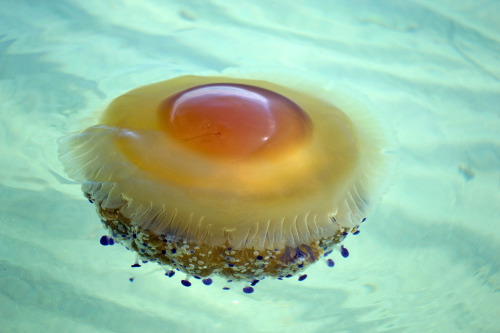

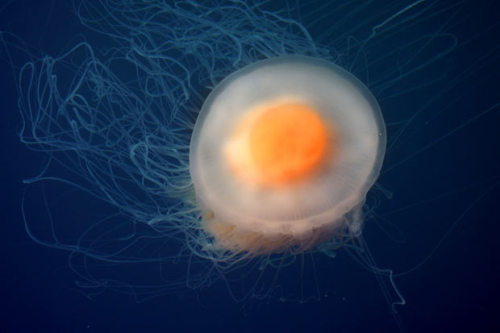
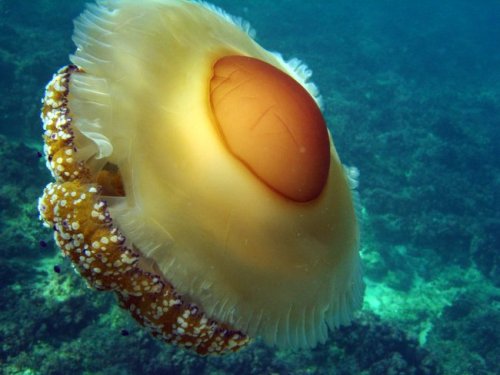
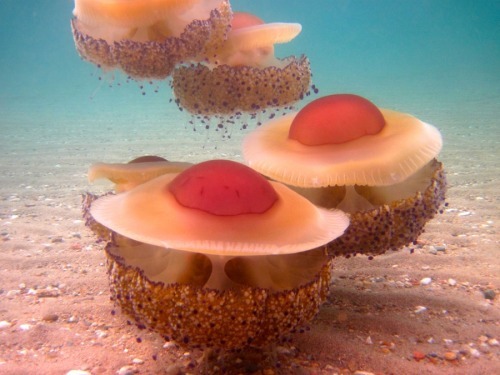
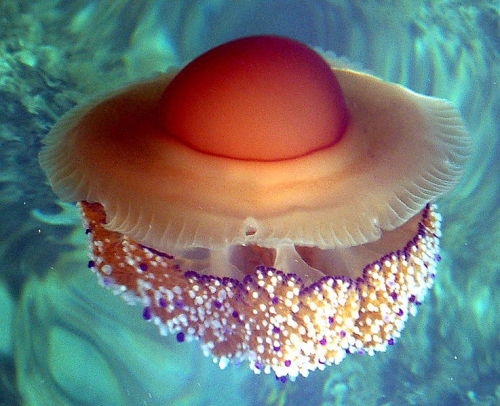
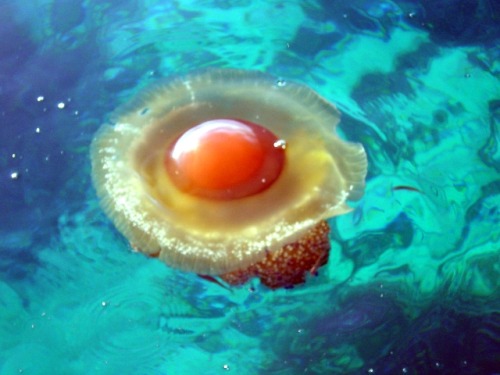
Fried Egg Jellyfish Are Kind of Adorable – & That’s No Yolk.
There are two species that hold the whimsical title of “Fried Egg Jellyfish”: Phacellophora camtschatica and Cotylorhiza tuberculata though the two are quite different from each other in all aspects beside appearance.
Phacellophora camtschatica is a huge jelly that prefers colder waters. It’s bell can reach up to 2 ft across and its dozens of tentacles reach over 20 ft long! If you don’t think this floating egg creature looks very menacing, you’d be right. It has a very weak sting and many small crustaceans take advantage of the jelly by riding on its bell (breakfast to go…?) while snatching up extra food.
Cotylorhiza tuberculata is a much smaller jellyfish that hangs out in warmer waters. It only reaches about 35 cm in diameter, so don’t go for this Fried Egg Jelly if you want a big breakfast. Unlike most jellyfish, C. tuberculata can swim on its own, without relying on the currents for movement. It’s sting (if you can even call it that) is so feeble that it has very little to no effect on humans at all. I mean, it does look like a breakfast food, after all… how powerful could it be?
Fellow Study Abroad Students
Most Common Profile
Fellow Students
My Background
Adjustments
The most common profile in study abroad is students from "elite colleges, white, female, major in arts/humanities, and have highly educated parents." Let's see how that compares to me. I am from a small liberal arts school (does that count as elite?), I am white (check), male (nope), I have majors in biology (nope) and Spanish (check), and both of my parents completed high school but never went to college so they would not be considered highly educated.
Now, compared to my fellow study abroad students, that profile fits a bit more. Girls out number guys by slightly more than 2 to 1, most of us are white, I think there are two science majors max (including myself), we have representatives from American University and other liberal arts schools, and I know at least some of them have parents that are medical doctors or have a doctorate in the arts or humanities. This is my first time outside the United States, but I know that at least five others have spent at least a few weeks outside of the U.S. at some point in their lives. So overall, everyone else is more well-traveled than me.
In general, I usually do not think that my background as a first generation college student affects my interactions with my peers. I think it's a little awkward when someone says that their father is a doctor or that their father has a Ph.D. in Philosophy, but usually, it's just someone that comes up in a casual conversation and they do not expect me to say what my parents do.
I think that I have learned to be independent and I usually do not rely on others when navigating the college system, and I think that is probably also true for learning how to adjust to life abroad. I just need some time and I make the adjustments on my own. I'm sure that the students that have been abroad may be able to adjust easier, but I don't really know if it is that different from my fellow study abroad students.

One of the major threats to sea turtles is entanglement in fishing gear and other marine debris.
Each year, threatened green sea turtles make their way to breeding grounds in the Northwestern Hawaiian Islands. Although these islands are largely uninhabited and are protected by Papahānaumokuākea Marine National Monument, ocean currents carry enormous quantities of trash here from around the world. More than 50 tons of debris enters monument waters each year! Here, fishing nets and other debris can entangle breeding adults and young hatchlings.
You can help protect these and other sea turtles by reducing the amount of plastic you use and participating in beach and watershed cleanups. What actions will you take to protect 🐢?
(Photo: Andy Collins/NOAA)
[Image description: A green sea turtle rests on a beach. In the foreground is a pile of derelict fishing nets.]
Family 2
Before...
Pets..
Health scares
Regrets?
I've already written one entry reflecting on how my family is doing without me and how I am doing without all of my family and friends. I've had to deal with a number of things that have happened at home.
Shortly before I left the United States, my grandfather faced a few health scares. By the time I left, everything had almost past, aside from some minor things. I knew there was a possibility that it could get worse while I was abroad, but I also knew that going abroad would not change any outcome.
Then, almost a month and a half ago, my family had to put one of our dogs to sleep. It was very sudden and everything happened in a few days. What made this more surprising is that our oldest dog is clearly showing his age and we all knew it was possible that I may not see him again, but our other dog is a little bit younger, but he always acts like a puppy so you would never know that he was ten years old. I even remember telling him that I didn’t have to worry about him because it seemed like he was in perfect health. Of course, I feel guilty about saying this, but there is no way I or anyone else could have known what was going to happen.
A few weeks before that, my dad broke his ankle and leg, and would be out of work for weeks. For me, the biggest impact this had was related to money, since my dad is the main bread winner in our family by a mile and it's not like we are rich or very comfortable to begin with. Now, today (Mother's Day in the U.S.), my mom called me because something else happened and my dad has been in critical condition all day and at this point, there is still a lot of uncertainty. It is harder to deal with since I am abroad, especially since a lot of people at SU have finished the semester and have been able to go home.
I think that all of this is plenty of reason to regret going abroad.....but I don't. Even though I lot has happened and is still happening, there is not much I could have done if I was home. More than likely, all of this would have still happened because stuff just happens in life. Don’t get me wrong, it is harder being abroad and being about from all of my friends and family but right now, I'm just reminding myself that stuff like this happens in life and often under the worst of circumstances (not that there is a best of circumstances).

Ocean heat waves increasing
This is a map showing a huge pool of warm surface water that formed in the North Pacific Ocean from 2013-2015. This pool of warm water was so stagnant that many weather scientists and forecasters casually started referring to it as “The Blob”, and it took the monster 2016 El Niño event to force the extra warm water to disperse. This huge pool of warm water likely contributed to some of the extreme weather events that hit North America in that timespan, as there was nothing like it in the North Pacific Ocean in the available weather records. Although this event was unprecedented in this location, newly available science shows that this type of event is happening with increasing frequency around the world as a result of the warming triggered by human release of greenhouse gases.
Keep reading
-
 technicontrastron liked this · 2 months ago
technicontrastron liked this · 2 months ago -
 herethereoranywhere liked this · 1 year ago
herethereoranywhere liked this · 1 year ago -
 queerfairylightswizard reblogged this · 1 year ago
queerfairylightswizard reblogged this · 1 year ago -
 wildernestt reblogged this · 1 year ago
wildernestt reblogged this · 1 year ago -
 sumechiayuu reblogged this · 1 year ago
sumechiayuu reblogged this · 1 year ago -
 abatonandouro reblogged this · 1 year ago
abatonandouro reblogged this · 1 year ago -
 buruuue reblogged this · 1 year ago
buruuue reblogged this · 1 year ago -
 x-clownin-around-x liked this · 1 year ago
x-clownin-around-x liked this · 1 year ago -
 marinebiology1 reblogged this · 2 years ago
marinebiology1 reblogged this · 2 years ago -
 rptv1 liked this · 2 years ago
rptv1 liked this · 2 years ago -
 rainsreverie reblogged this · 2 years ago
rainsreverie reblogged this · 2 years ago -
 possiblyanaardvark liked this · 2 years ago
possiblyanaardvark liked this · 2 years ago -
 buwun-blog liked this · 2 years ago
buwun-blog liked this · 2 years ago -
 anerdssketchpileblr liked this · 2 years ago
anerdssketchpileblr liked this · 2 years ago -
 prettierecho reblogged this · 2 years ago
prettierecho reblogged this · 2 years ago -
 meowdog reblogged this · 2 years ago
meowdog reblogged this · 2 years ago -
 plush-cakes reblogged this · 2 years ago
plush-cakes reblogged this · 2 years ago -
 daikoski reblogged this · 2 years ago
daikoski reblogged this · 2 years ago -
 strawberrycowe reblogged this · 2 years ago
strawberrycowe reblogged this · 2 years ago -
 mysteriouslyvirtualmiracle reblogged this · 2 years ago
mysteriouslyvirtualmiracle reblogged this · 2 years ago -
 finalgirlgraveyard liked this · 2 years ago
finalgirlgraveyard liked this · 2 years ago -
 fidgety-lil-raccoon reblogged this · 2 years ago
fidgety-lil-raccoon reblogged this · 2 years ago -
 woahstim reblogged this · 2 years ago
woahstim reblogged this · 2 years ago -
 thinking-outside-the-giftbox18 liked this · 2 years ago
thinking-outside-the-giftbox18 liked this · 2 years ago -
 flyhighaangle liked this · 2 years ago
flyhighaangle liked this · 2 years ago -
 daikoski liked this · 2 years ago
daikoski liked this · 2 years ago -
 8stims reblogged this · 2 years ago
8stims reblogged this · 2 years ago -
 notamean-greenbean liked this · 3 years ago
notamean-greenbean liked this · 3 years ago -
 sparrow-ceiling liked this · 3 years ago
sparrow-ceiling liked this · 3 years ago -
 sliceofdyke reblogged this · 3 years ago
sliceofdyke reblogged this · 3 years ago -
 sliceofdyke liked this · 3 years ago
sliceofdyke liked this · 3 years ago -
 bobv48-blog liked this · 3 years ago
bobv48-blog liked this · 3 years ago -
 catarsisouit reblogged this · 3 years ago
catarsisouit reblogged this · 3 years ago -
 catarsisouit liked this · 3 years ago
catarsisouit liked this · 3 years ago -
 decafeinado liked this · 3 years ago
decafeinado liked this · 3 years ago -
 nkadulova liked this · 3 years ago
nkadulova liked this · 3 years ago -
 shaggy-reg liked this · 3 years ago
shaggy-reg liked this · 3 years ago -
 lefrog liked this · 3 years ago
lefrog liked this · 3 years ago -
 d4n1k9s reblogged this · 3 years ago
d4n1k9s reblogged this · 3 years ago -
 d4n1k9s liked this · 3 years ago
d4n1k9s liked this · 3 years ago -
 para-la-wea-oe reblogged this · 3 years ago
para-la-wea-oe reblogged this · 3 years ago

Blog dedicted to phytoplankton. Phytoplankton are microscopic organisms that are responsible for half of the photosynthesis that occurs on Earth. Oh, and they look like art... Follow to learn more about these amazing litter critters! Caution: Will share other ocean science posts!Run by an oceanographer and phytoplankton expert. Currently a postdoctoral researcher.Profile image: False Colored SEM image of Emiliania huxleyi, a coccolithophore, and the subject of my doctoral work. Credit: Steve Gschmeissner/ Science Photo Library/ Getty ImagesHeader image: Satellite image of a phytoplankton bloom off the Alaskan Coast, in the Chukchi SeaCredit: NASA image by Norman Kuring/NASA's Ocean Color Web https://earthobservatory.nasa.gov/images/92412/churning-in-the-chukchi-sea
158 posts
